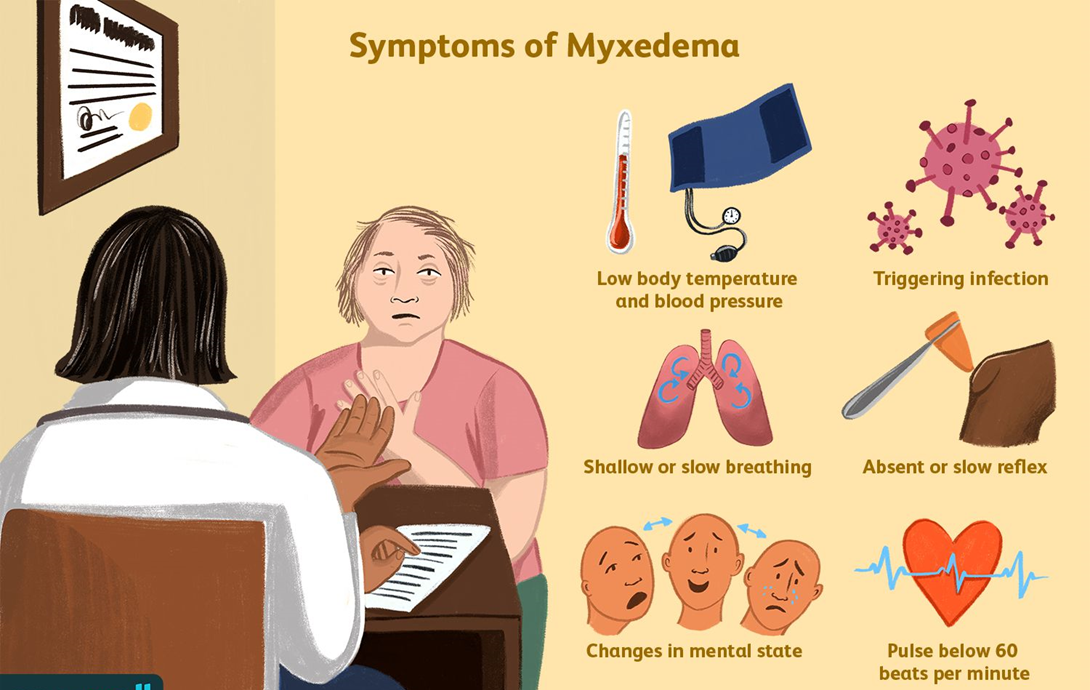A nurse is caring for a client who is in a myxedema coma. Which of the following actions should the nurse take?
Place the client on aspiration precautions.
Turn the client every 4 hours.
Check the client’s blood pressure every 2 hours.
Initiate measures to cool the client.
The Correct Answer is A
Choice A Reason:
Place the client on aspiration precautions: Myxedema coma is a severe form of hypothyroidism that can lead to decreased mental function and a reduced level of consciousness. These conditions increase the risk of aspiration, which can lead to pneumonia and other complications. Therefore, placing the client on aspiration precautions is crucial to prevent these risks. Aspiration precautions may include elevating the head of the bed, monitoring swallowing ability, and providing thickened liquids if necessary.

Choice B Reason:
Turn the client every 4 hours: While turning the client regularly is important to prevent pressure ulcers, it is not the primary action needed for a client in a myxedema coma. The focus should be on stabilizing the client’s condition and preventing life-threatening complications such as aspiration, respiratory failure, and cardiovascular collapse.
Choice C Reason:
Check the client’s blood pressure every 2 hours: Monitoring vital signs, including blood pressure, is essential for clients in a myxedema coma. However, it is not the most critical action compared to preventing aspiration. Blood pressure should be monitored regularly, but the frequency can be adjusted based on the client’s condition and stability.
Choice D Reason:
Initiate measures to cool the client: Clients in a myxedema coma typically present with hypothermia (low body temperature), not hyperthermia (high body temperature). Therefore, initiating measures to cool the client would be inappropriate and could worsen their condition. Instead, measures to warm the client, such as using blankets and adjusting room temperature, are more appropriate.
Nursing Test Bank
Naxlex Comprehensive Predictor Exams
Related Questions
Correct Answer is A
Explanation
Choice A reason:
Hypotension (low blood pressure), tachycardia (rapid heart rate), and lethargy are critical symptoms that can indicate a life-threatening condition such as shock or severe dehydration. Hypotension can lead to inadequate perfusion of vital organs, resulting in multi-organ failure if not promptly addressed1. Tachycardia is often a compensatory mechanism for hypotension, and lethargy indicates decreased cerebral perfusion. Immediate intervention is required to stabilize the patient’s condition and prevent further deterioration.
Choice B reason:
Dizziness with a headache rated 7/10 on the numeric scale is concerning but not immediately life-threatening. These symptoms could indicate a variety of conditions, such as migraine, vertigo, or even a mild concussion. While the patient should be assessed and treated, they do not present the same immediate risk as hypotension and tachycardia.
Choice C reason:
Abdominal pain, hypertension (high blood pressure), and constipation are symptoms that need medical attention but are not immediately life-threatening. Hypertension can lead to serious complications if left untreated, but it does not require the same urgent intervention as hypotension. Abdominal pain and constipation, while uncomfortable and potentially indicative of underlying issues, do not pose an immediate threat to life.
Choice D reason:
Febrile (fever), tachycardia, and vomiting are symptoms that suggest an infection or other acute illness. While these symptoms are concerning and need prompt evaluation, they do not pose the same immediate risk as hypotension and tachycardia. Fever and vomiting can lead to dehydration, but this typically develops over a longer period compared to the rapid deterioration seen with hypotension.
Correct Answer is ["A","B","C"]
Explanation
Choice A: Observe for clear drainage.
Reason: Observing for clear drainage is important as it can indicate cerebrospinal fluid (CSF) leakage, especially after nasal or sinus surgery. CSF leakage is a serious complication that requires immediate medical attention. Clear drainage from the nose should be tested for the presence of glucose, which can confirm if it is CSF.
Choice B: Assess for signs of bleeding.
Reason: Assessing for signs of bleeding is crucial in the immediate postoperative period. Nasal packing can sometimes mask ongoing bleeding, so it is important to monitor for any signs of excessive blood loss. This includes checking for blood-soaked dressings, frequent swallowing (which can indicate blood trickling down the throat), and changes in vital signs such as increased heart rate and decreased blood pressure.
Choice C: Watch the client for frequent swallowing.
Reason: Watching the client for frequent swallowing is important because it can be a sign of posterior nasal bleeding. Blood can trickle down the back of the throat, causing the client to swallow frequently. This is a subtle but significant sign that should prompt further investigation and possible intervention.
Choice D: Change the nasal packing.
Reason: This choice is incorrect. Nasal packing should not be changed by the nurse without specific orders from the physician. Changing the packing prematurely can disrupt the surgical site, cause bleeding, and increase the risk of infection. The packing is usually removed by the surgeon or under their direct supervision.
Choice E: Administer a nasal steroid to decrease edema.
Reason: Administering a nasal steroid can help reduce inflammation and edema in the nasal passages. However, this should only be done if prescribed by the physician. Nasal steroids can help improve breathing and reduce discomfort, but they must be used according to medical guidance to avoid potential side effects.
Whether you are a student looking to ace your exams or a practicing nurse seeking to enhance your expertise , our nursing education contents will empower you with the confidence and competence to make a difference in the lives of patients and become a respected leader in the healthcare field.
Visit Naxlex, invest in your future and unlock endless possibilities with our unparalleled nursing education contents today
Report Wrong Answer on the Current Question
Do you disagree with the answer? If yes, what is your expected answer? Explain.
Kindly be descriptive with the issue you are facing.
